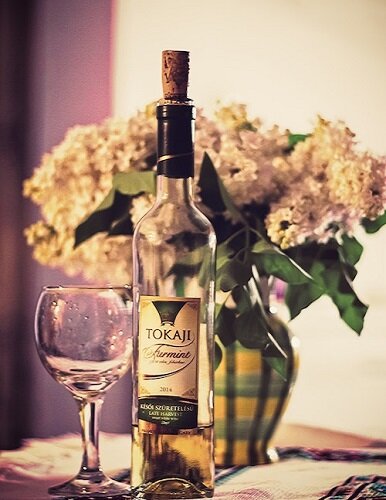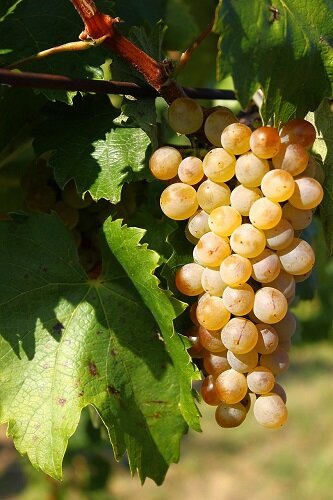Meet Hungarian Furmint, Your New Dry House White
The Hungarian white grape long responsible for luscious dessert wines also makes an enticing dry style.
The grape variety furmint might sound unfamiliar and tasting the dry versions of it for the first time can also be a bit baffling because it doesn’t really taste like anything else. It’s acidic without being pungent, full-bodied yet somehow lean and lithe, not considered aromatic yet far from neutral or lacking in style and touts a savory line of minerality and salinity running throughout. One sip and you might be apt to describe it as licking a slab of granite that’s been squirted with lemon juice—but in a great way.
Furmint bottle Photo by Ferenc Almasi on Unsplash
If you’ve even heard of furmint, more than likely it’s because you’ve tried Tokaji, Hungary’s gorgeously made (and one could argue under-appreciated) sweet wine that draws comparisons to Sauternes for its botrytized character and honeyed notes. But winemakers are increasingly using furmint in dry table wines, whose broad appeal extends to fans of sauvignon blanc, pinot grigio and unoaked chardonnay. “Dry furmint is one of my favorite white wines simply because it has so much to offer,” declares Nicole Bernard, wine director and sommelier of Trummer’s Restaurant in Clifton, Virginia. “Some have flavors of melon, candied orange and baked apple, while others have displayed notes of fresh green apple, stone fruit and lemon
One of Bernard’s favorites hails from Tokaj-Oremus Winery, located in the heart of the Tokaj-Hegyalja region, whose vineyard Mandolás is planted with furmint. The winery was purchased in the early 1990s by the Alverez family, who also owns the prestigious Vega Sicilia in Spain’s Ribera del Duero region, which has bet on the increasing popularity of the grape in recent years. Technical director András Bacsó has definitely seen versatile, food-friendly dry furmint getting more attention. “[It has a] young and fruity character with mineral aromas from the soil offering unctuousness and a flavorful and silky palate, while leaving an acidic fresh finish typical of the Tokaji region.”
Furmint Grape Cluster by Andrs.kovacs is licensed under CC BY-SA 3.0
In the vineyard furmint has a lot going for it, including resistance to diseases, hardiness to winter freezing and an affinity for a sunny exposure. However, those same tight, compact clusters that encourage the botrytis highly desired for Tokaji dessert wine can make furmint quite persnickety for winemakers seeking dry styles. Bacsó says producers are responding by planting clones with looser bunches, which allows for increased airflow to keep grapes dry and healthy. Furmint is a late ripening varietal, and hang time and vinification both dramatically affect the wine’s style, according to wine merchant and educator Gábor Bánfalvi, who along with his wife Carolyn operate a wine store and Hungarian Wine Club called Taste Hungary, splitting their time between Washington, D.C. and Budapest. Picked on the earlier side, fermented in stainless steel and bottled young, furmint is easy-drinking, crisp, not too serious and lower in alcohol--perfect as an aperitif.
But winemakers who harvest furmint a bit later from low-yield vineyards and age it judiciously will be rewarded with complexity, smoothness and elegant flavors, Bánfalvi says. Retaining a few grams of residual sugar balances the acidity and makes the wine rounder, while batonnage adds creaminess and a fuller body. “If you add the minerality from volcanic vineyards on top of all this, you will end up with some of the best white wines in the world,” he says, with ripe mango and apricot, lime and almond. Its acidity coupled with moderate barrel aging also equates to bottles with high ageing potential, during which time it picks up color and notes of green walnut and hazelnut.
As for pairing furmint with food, Bernard believes it’s a great companion to dishes like pan-roasted perch with lemon zest and brown butter, roasted pork loin crusted with candied pecans and roasted carrots dressed with orange zest, ginger, coconut oil and yellow curry. Bacsó says it goes smashingly with starters like cream soups, salads, seafood or white asparagus, mains including salmon, trout, roasted chicken and duck and Asian cuisine.
Bánfalvi has seen dry furmint trending in Hungary for the past ten or fifteen years in both popularity and production. “People like it for its refreshing acidity and because it has so many different faces,” he says. “The flavor and aroma profile can vary between green apple, pear, grapefruit, lime, white peach and exotic fruits.” Youthful, vibrant stainless steel expressions are affordable and quaffable (and found in many native bars), while wine geeks bowl over comparing producers, styles and regions of their complex counterparts. What’s more, he says, the grape is blessedly easier to pronounce than some of Hungary’s other indigenous varietals like Hárslevelű, Királyleányka or Ezerjó.
Bottles to try:
Furmint Bodega Oremus 5
Oremus Mandolás Furmint 2017 ($32), refreshing and ever so slightly rounder than its 2018 sibling, this wine has subtle aromas of green apple, with lemon zest and minerality on the palate and a vibrant finish. Try it with fusilli pasta tossed with lemon juice and zest, high-quality jarred tuna and freshly-grated parmesan cheese.
Oremus Mandolás Furmint 2018 ($34), lean and mean, this wine doesn’t have too much in the way of fruit notes, but it excites your palate with the minerality of rocky granite, a touch of tart lime juice and an elegantly fresh yet subtle finish. It’s perfect with an icy cold plate of just-shucked East Coast briny oysters dressed with nothing more than a lemon wedge.
Erzsébet Estate Furmint 2015 ($26), with grapes from four different vineyards--Betsek and Király add minerality, Zafír lends elegance and balance and old-vine Pécsi gives complexity and age-worthiness--the wine tempts with crisp acidity, heady scents of white peaches and flowers and notes of tart green apples.
Kvaszinger Estate Furmint 2016 ($24), fermented and aged in stainless steel for a few months before maturing in 500-liter oak barrels for another 10 months, this wine has signature minerality, balanced acidity and elegant citrus notes.



